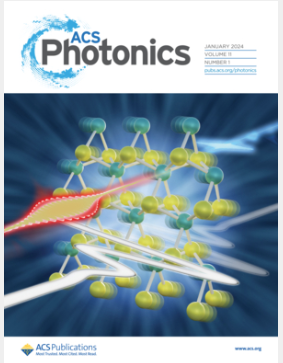用于近红外光电探测器的局部相工程 MoTe2
IF 6.5
1区 物理与天体物理
Q1 MATERIALS SCIENCE, MULTIDISCIPLINARY
引用次数: 0
摘要
过渡金属二卤化物(TMDs)具有很强的光-物质相互作用和各种带隙能量,是二维(2D)光电应用的理想系统。最近,人们发现了改变 TMD 晶体相的新技术,从而可以创建横向异质结构和设计全二维电路。因此,迄今为止,相位工程 TMD 器件在光电应用方面的潜在优势在很大程度上仍未得到开发。这些系统中产生光电流的主要机制仍不清楚,阻碍了新型全二维光电器件的进一步发展。在这里,我们制作了局部相位工程化的 MoTe2 光电器件,形成了一个金属(1T′)半导体(2H)横向结,并揭示了光电流产生的主要机制。我们发现,光电流源自 1T′-2H 结,在结的 2H MoTe2 侧达到最大值。这一观察结果以及非线性 IV 曲线表明,在这些系统中,光生伏打效应在光子-电荷电流转换过程中发挥了重要作用。此外,1T′-2H MoTe2 异质结器件在 700-1100 纳米波长范围内表现出快速的光电响应,上升和下降时间分别为 113 和 110 μs,比直接接触的 2H MoTe2 器件快两个数量级。这些结果表明了局部相位工程在全二维光电电路中的应用潜力。本文章由计算机程序翻译,如有差异,请以英文原文为准。

Locally Phase-Engineered MoTe2 for Near-Infrared Photodetectors
Transition-metal dichalcogenides (TMDs) are ideal systems for two-dimensional (2D) optoelectronic applications owing to their strong light-matter interaction and various band gap energies. New techniques to modify the crystallographic phase of TMDs have recently been discovered, allowing the creation of lateral heterostructures and the design of all-2D circuitry. Thus, far, the potential benefits of phase-engineered TMD devices for optoelectronic applications are still largely unexplored. The dominant mechanisms involved in photocurrent generation in these systems remain unclear, hindering further development of new all-2D optoelectronic devices. Here, we fabricate locally phase-engineered MoTe2 optoelectronic devices, creating a metal (1T′) semiconductor (2H) lateral junction and unveil the main mechanisms at play for photocurrent generation. We find that the photocurrent originates from the 1T′–2H junction, with a maximum at the 2H MoTe2 side of the junction. This observation, together with the nonlinear IV-curve, indicates that the photovoltaic effect plays a major role in the photon-to-charge current conversion in these systems. Additionally, the 1T′–2H MoTe2 heterojunction device exhibits a fast optoelectronic response over a wavelength range of 700–1100 nm, with a rise and fall times of 113 and 110 μs, respectively, 2 orders of magnitude faster when compared to a directly contacted 2H MoTe2 device. These results show the potential of local phase-engineering for all-2D optoelectronic circuitry.
求助全文
通过发布文献求助,成功后即可免费获取论文全文。
去求助
来源期刊

ACS Photonics
NANOSCIENCE & NANOTECHNOLOGY-MATERIALS SCIENCE, MULTIDISCIPLINARY
CiteScore
11.90
自引率
5.70%
发文量
438
审稿时长
2.3 months
期刊介绍:
Published as soon as accepted and summarized in monthly issues, ACS Photonics will publish Research Articles, Letters, Perspectives, and Reviews, to encompass the full scope of published research in this field.
 求助内容:
求助内容: 应助结果提醒方式:
应助结果提醒方式:


